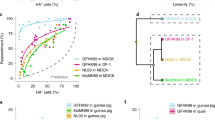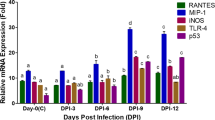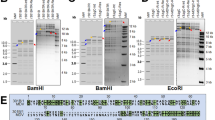Abstract
Oncogenic avian retroviruses can be classified into three groups: sarcoma viruses, acute leukaemia viruses and lymphoid leukosis viruses (LLVs)1. Sarcoma and acute leukaemia viruses transform fibroblasts and/or haematopoietic cells in culture and induce tumours with short latent periods in infected birds. In contrast, LLVs do not transform cells in vitro and require long latent periods before formation of neoplasms in vivo. The most frequent neoplasm induced by LLVs is malignant lymphoma of the bursa of Fabricius, but LLVs also induce other neoplasms, including sarcomas, nephroblastomas and erythroblastosis2. The genomes of both sarcoma and acute leukaemia viruses contain specific genes responsible for viral oncogenicity1,3–5, whereas the genome of LLVs apparently includes only genes required for virus replication. The genetic basis for the low oncogenic potential of LLVs is therefore obscure. The present experiments indicate that LLV-induced tumours contain transforming genes that can be detected by transfection of NIH 3T3 mouse cells. These transforming genes are not linked to LLV DNA sequences, suggesting that oncogenesis by LLVs may result from indirect activation of cellular transforming genes.
This is a preview of subscription content, access via your institution
Access options
Subscribe to this journal
Receive 51 print issues and online access
$199.00 per year
only $3.90 per issue
Buy this article
- Purchase on Springer Link
- Instant access to full article PDF
Prices may be subject to local taxes which are calculated during checkout
Similar content being viewed by others
References
Hanafusa, H. Compreh. Virol. 10, 401–483 (1977).
Graf, T. & Beug, H. Biochim. biophys. Acta 516, 269–299 (1978).
Graf, T., Ade, N. & Beug, H. Nature 275, 496–501 (1978).
Duesberg, P. H. & Vogt, P. K. Proc. natn. Acad. Sci. U.S.A. 76, 1633–1637 (1979).
Roussel, M. et al. Nature 281, 452–455 (1979).
Neiman, P., Payne, L. N. & Weiss, R. A. J. Virol. 34, 178–186 (1980).
Andersson, P., Goldfarb, M. P. & Weinberg, R. A. Cell 16, 63–75 (1979).
Lowy, D. R., Rands, E. & Scolnick, E. M. J. Virol. 26, 291–298 (1978).
Copeland, N. G., Zelenetz, A. D. & Cooper, G. M. Cell 17, 993–1002 (1979).
Copeland, N. G., Zelenetz, A. D. & Cooper, G. M. Cell 19, 863–870 (1980).
Copeland, N. G. & Cooper, G. M. J. Virol. 33, 1199–1202 (1980).
Shih, C., Shilo, B.-Z., Goldfarb, M. P., Dannenberg, A. & Weinberg, R. A. Proc. natn. Acad. Sci. U.S.A. 76, 5714–5718 (1979).
Cooper, G. M., Okenquist, S. & Silverman, L. Nature 284, 418–421 (1980).
Southern, E. M. J. molec. Biol. 98, 503–517 (1975).
Hsu, T. W., Sabran, J. L., Marks, G. E., Guntaka, R. V. & Taylor, J. M. J. Virol. 28, 810–818 (1978).
Hughes, S. H. et al. Cell 15, 1397–1410 (1978).
Sabran, J. L. et al. Virol 29, 170–178 (1979).
Shank, P. R. et al. 15, 1383–1395 (1978).
Spector, D. H., Varmus, H. E. & Bishop, J. M. Proc. natn. Acad. Sci. U.S.A. 75, 4102–4106 (1978).
Tsichlis, P. N. & Coffin, J. M. J. Virol. 33, 238–249 (1980).
Koshy, R., Wong-Staal, F., Gallo, R. C., Hardy, W. & Essex, M. Virology 99, 135–144 (1979).
Neiman, P. E., Payne, L. N., Jordan, L. & Weiss, R. A. Cold Spring Harb. Conf. Cell Proliferation (in the press).
Crittenden, L. B., Witter, R. L., Okazaki, W. & Neiman, P. E. J. natn. Cancer Inst. 63, 191–200 (1979).
McGrath, M. S. & Weissman, I. L. Cell 17, 65–75 (1979).
Witter, R. L. et al. Avian Path. 8, 487–489 (1979).
Neiman, P. E., Purchase, H. G. & Okazaki, W. Cell 4, 311–319 (1975).
Taylor, J. M., Illmensee, R. & Summers, J. Biochim. biophys. Acta 442, 324–330 (1976).
Rigby, P. W. S., Dieckman, M., Rhodes, C. & Berg, P. J. molec. Biol. 113, 237–251 (1977).
Wahl, G. M., Stern, M. & Stark, G. R. Proc. natn. Acad. Sci. U.S.A. 76, 3683–3687 (1979).
Author information
Authors and Affiliations
Rights and permissions
About this article
Cite this article
Cooper, G., Neiman, P. Transforming genes of neoplasms induced by avian lymphoid leukosis viruses. Nature 287, 656–659 (1980). https://doi.org/10.1038/287656a0
Received:
Accepted:
Issue Date:
DOI: https://doi.org/10.1038/287656a0
This article is cited by
-
Relationship of Blym genes to repeated sequences
Nature (1986)
-
Relationship of Blym genes to repeated sequences
Nature (1986)
-
Transferrin receptor: Its biological significance
The Journal of Membrane Biology (1985)
Comments
By submitting a comment you agree to abide by our Terms and Community Guidelines. If you find something abusive or that does not comply with our terms or guidelines please flag it as inappropriate.



